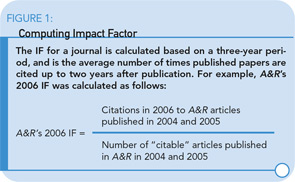Originally conceived to help libraries and researchers be selective in journal management, the influence of IF has grown and spread significantly, raising issues about the process of the calculation and its current uses and abuses.
According to Thomson Scientific, which computes journal IFs, the number is “a measure of the frequency with which the ‘average article’ in a journal has been cited in a particular year or period.” (See Figure 1)
In 2004, the fully automated system applied its algorithms to 27 million citations in 5,968 science journals and 1,712 social science journals. Originally, IF was intended as a practical quantitative tool to rank, evaluate, categorize, and compare journals worldwide. Now it is seen as a measure of the quality of a journal, its contents, and its authors. Recently, however, IFs have been used, or abused according to Dr. Garfield, as a dynamic in hiring decisions and in awarding grants and tenure. “It never occurred to me that ‘impact’ would become so controversial,” says Dr. Garfield.
Over the past 10 years, IF has come to routinely be applied in ways that Dr. Garfield never imagined. “The term ‘impact factor’ has gradually evolved, especially in Europe, to describe both journal and author impact,” he says.
Repercussions of Rank
According to Michael D. Lockshin, MD, editor of A&R, in countries such as England, Germany, France, and China, laboratory space, promotions, and budgets can be based on the IF of the journals in which an author publishes “Academics in these countries are desperate to be in high–impact factor journals,” says Dr. Lockshin, who is professor of medicine and obstetrics-gynecology at Weill Medical College and an attending physician at the Hospital for Special Surgery in New York City. In Spain, researchers have a legal right to be rewarded for publishing in high-impact journals, and in China some universities require PhD candidates to publish two articles in high-impact journals before they are allowed to earn their doctorate.
Although this kind of application is not as prevalent in the United States, other issues are influenced by IF. Dr. Garfield has wryly referred to “Citation Sanity and Insanity: The Obsession and Paranoia of Citations and Impact Factor” as an alternative title to an address he gave in 2005 to the International Congress of Peer Review and Biomedical Publication.1
The allegations against this system run from claims that IF reporting can be artificially manipulated by editors who are trying to raise their numbers to complaints that while academics vie for limited space in high-IF journals, their work is being delayed from reaching the community in the most timely fashion.




